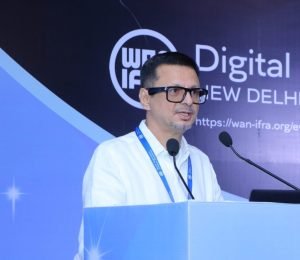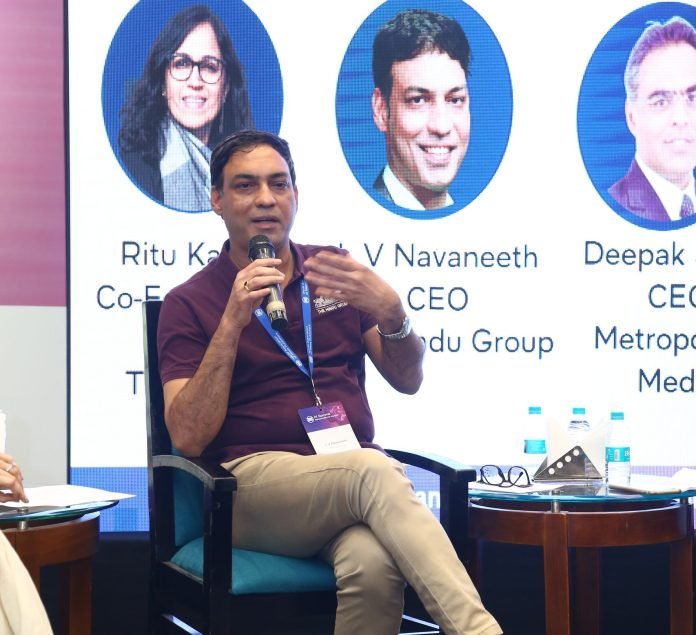In the past few years, news media has been in a phase of metamorphosis – a radical change, especially the digital surge amid the global Covid-19 pandemic, and more recently with the advent of artificial intelligence. New digital-only and video-only news media organizations targeting the print-shy youth have forced legacy media houses hosting leading newspapers to rethink their strategy and go hybrid – integrating digital into their operations like never before.
The Chennai-based The Hindu Group, which houses the print newspapers The Hindu and The Hindu Businessline, and the magazines Frontline and Sportstar, was one of the early movers among the traditional media houses. The group successfully jumped onto the digital bandwagon while maintaining the sanctity of the print editions.
The Indian Printer and Publisher had a conversation with LV Navaneeth, CEO, The Hindu Group, and Pradeep Gairola, VP and head of digital, The Hindu Group, to learn more about the company’s strategy in the changing times.
Print media recovery
The print media took a major hit during the Covid-19 pandemic, with almost zero circulation and plunging revenue for nearly all media houses, barring some in Kerala. Things now seem to be better as suggested by many reports and yearly results even though there are diverse opinions on the recovery of print and future adex projections. Some say print is here to say while others point to a hybrid existence with digital.
According to Navaneeth, print media has recovered well since the initial stages of the Covid pandemic in terms of both circulation and ad revenues and as a result, profitability. Speaking specifically about The Hindu Group, he said, “Things are indeed looking good for print and The Hindu group; the last three years have been satisfactory in terms of both performance and investments in some key areas.”
Ad revenue for print, Navaneeth says, has been growing in the last couple of years and he expects the trend to broadly continue this year. At the same time, digital revenues, while still a small but growing percentage of overall revenues, are increasingly important from the advertising and subscription point of view.
Many newspapers cut down on pagination to reduce costs as newsprint is one of the biggest expenses for print media. A few newspapers have reverted to the old pagination but many others have still stuck to the reduced number of pages. Navaneeth says while most newspapers have increased their pagination over the last three years after the peak Covid slash, he feels the current offering is adequate as the newspapers are probably better curated today than before. “However, newspapers do have higher pagination during events of importance to ensure readers are adequately informed.”
Talking about the redesign of the Frontline magazine last year and the magazine industry’s future, Navaneeth says the response to the revamp has been encouraging as Frontline went through some more changes beyond design. “We believe there is a space for serious long-form journalism and that is what Frontline addresses. The redesign helped Frontline revisit its digital assets and we are happy with the feedback from the readers to both the physical and digital products. My view is that magazines need to find sizeable niche spaces to grow and be relevant. They need to monetize the digital assets in addition to the physical products.”
Digital shift and attracting the youth

As part of its digital transformation, The Hindu brought in two independent news consultants – Ola Henriksson from Sweden and Lars Dahmén of HiGear Transformation AB, to streamline the flow of stories online and align it with the consumption behavior of its users as well as enhance the quality of storytelling through the use of advanced technological tools.
According to Gairola, the association with Henriksson and Dahmén was highly rewarding. “We collaborated with them on a project aimed at refining our newsroom workflows to better align with our digital business objectives.”
Gairola says their focus on streamlining operations and fostering a digital-first mindset in the news bureaus was particularly valuable. “Although this is a long-term project, we were encouraged by the positive outcomes, including enhanced cross-functional collaboration and a significant shift from print-focused deadlines to more user-oriented publishing practices. Their expertise has been instrumental in advancing our goals.”
Many legacy brands and digital news outlets have gone behind a paywall for premium content and even for the ePaper. However, convincing readers to pay for news online is a challenge. Navaneeth says The Hindu Group has been on this journey for some time and is encouraged by the results.
While it is a difficult journey, he believes it is important for an organization to value its content and convince readers to see enough value so that they are willing to pay for it. Navaneeth says it is important for media organizations to reduce dependence on advertising alone and build newer revenue streams in the digital ecosystem. “We are of the view that subscription revenue is key to achieving that objective.”
Getting the attention of the young audience, which seems to be drawn away from news, is an uphill task for both digital and even more for print media. We asked Navaneeth and Gairola what they think is needed to get the youth to read and what The Hindu has done to get GenZ on board.
They say the challenge from the younger audience is not necessarily of news consumption but how and where they consume news. “We still have a sizeable young-ish audience consuming our physical products. On digital, the attempt is to look at areas of content that interest younger readers from a news, views, and utility point of view and develop both width and depth around these areas,” Navaneeth said.
Gairola explained that in addition to delivering quality news, the media house employs a comprehensive strategy to onboard and retain both subscribers. They engage the audience through personalized newsletters, exclusive journalist sessions, and tailored content. “Our mobile app plays a key role, offering features such as customizable notifications and offline reading, while our active social media presence fosters community and loyalty,” he explained.
Recognizing the global challenge of subscriber retention, The Hindu Group continuously adapts successful practices from other markets. For example, while monthly subscriptions are common in the West, annual packages work better in India due to the local payment landscape, Gairola explained.
“Understanding the critical importance of the initial subscriber experience, we have established a dedicated onboarding team and rigorously monitor key performance indicators (KPIs) to enhance retention. We find bundled offers highly effective, aiming to maximize perceived subscriber value through consistent engagement. While these efforts have significantly improved retention rates, we acknowledge there is still much work to be done to meet our goals,” Gairola said.
AI and data
Coming to technology, AI is the big buzzword these days. Many media houses in the West are using it for content and videos and others to optimize operations. Indian media houses have also taken to AI in a broad way as suggested in the recent Wan-Ifra and INMA news media conferences.
Like many others, The Hindu Group is experimenting with the usage and use cases around AI, Navaneeth said, adding they have seen some success in some areas and continue to explore newer areas. “We are fairly buoyant about the benefits of the use of AI in our business but ensure there is always a human in the loop when it comes to the use of consumer-facing content that uses AI.”
At Wan-Ifra’s AI Summit in Bengaluru this year, Nagaraj Nagabushanam, The Hindu’s vice-president, data and analytics, made a presentation on how the organization is using AI to help fine-tune and develop content and services to appeal to specific audiences.
According to Navaneeth, data and data analytics play a significant role in helping them analyze patterns, audience cohorts, areas of interest, content areas to focus on for building width and/or depth, discoverability of content, and monetization of the group’s digital business.

















